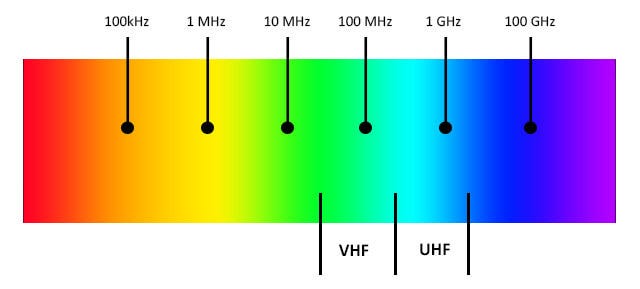When it comes to buying two way radios, one of the most important things to consider is whether you want UHF two way radios or VHF two way radios. Different businesses need different frequency ranges depending on the size of their operation, their budget, and their team’s location.
But what’s the difference and what does your company need?
The main difference between these two options is in the range of frequencies that they use. But there’s more…
1. UHF vs VHF - what’s the difference?
VHF radio (Very High Frequency)
VHF radios offer a larger broadcast range, using radio waves from 30 MHz to 300 MHz. Unfortunately, they have fewer channels, which can lead to congestion and interference from other nearby two way radios.
Generally, VHF radios are less expensive and have been around for much longer than UHF radios and.
Very High Frequency two way radios are ideal for the outdoors and across large areas because they have a tendency for signal degradation in urban areas where there are many obstacles like tall buildings. They’re also ideal in areas where there are not a lot of people, so they can operate with reduced interference. Broadly speaking, VHF radios are better suited for industries such as agriculture and recreation.
UHF radio (Ultra High Frequency)
UHF two way radio waves don’t travel as far as VHF radio waves, so they have a reduced range. However, they have a wider frequency spectrum, so they afford great coverage with little interference from other users.
Due to the higher frequency that they operate on, UHF radios use up battery power more quickly so they’re not ideal if workers don’t have easy access to a charging station.
One of the biggest pros of UHF radios is that they do a much better job of penetrating barriers in urban locations, like concrete, steel, and wood. So this kind of radio is best suited for use indoors, including buildings with multiple floors, in industries such as manufacturing, distribution, education, retail, hospitality, and healthcare. They also work well for businesses that function in both indoor and outdoor settings, where there are a lot of surrounding buildings.
Summary:
- Radios with lower frequencies (VHF) have longer wavelengths, making them ideal for work across wide areas free from obstruction, as well as outdoor use.
- UHF radios operate at a higher frequency, which is ideally suited for wireless communications that need to penetrate buildings, walls, concrete, or other barriers. For this reason, UHF radios are best for indoor communication where obstacles, such as walls, are present.
2. MHz frequencies
When you’re shopping for two way radio systems, you’ll likely see the frequency expressed as MHz, or Megahertz, which measures the speed of electronic devices.
Commercial two-way VHF radios typically have a high band of between 136-174 MHz, while commercial two-way UHF radios have a high band of 450-512 MHz.
The lower the frequency in Megahertz, the longer the radio wavelength will travel. On the other hand, the higher the frequency in Megahertz, means that your signal can pass through obstructions without dropping.


3. Compatibility with existing systems
It’s important to know your radio system’s existing frequency before purchasing radios because, in order for them to talk to each other, they need to be the same.
Every wireless communication device has operating frequencies controlled by the FCC, which means that, in order to communicate, radios need to be on the same frequency.
Additionally, radios now come in either analog or digital. Your fleet can be one of the other, but not both.
If you're unsure about the compatibility of your current radios, contact Amerizon for assistance.
4. Ability to improve radio signals
There are many ways to improve your radio signal but the easiest would be improving your antenna.
UHF two-way radios have shorter wavelengths, and thus typically have a shorter antenna, but you can improve the performance of a VHF radio, giving it an even longer range, simply by increasing the size of the antenna.
If you’re having trouble with interference on your VHF radio, you can try to locate the source of this interference by listening to the receiver and noting changes in volume.
Generally, the best way to improve your radio signal is by switching from analog to digital. Digital radio signals offer a significant increase in clarity and coverage. Many of our most popular Motorola two-way radios allow you to upgrade your fleet from analog to digital when the time is right for your business.
5. UHF vs. VHF - which is better for your organization?
Below is a list of representative industries and organizations by radio frequency type:
|
VHF
|
UHF
|
Possessing the right communication infrastructure helps you keep your work teams connected and informed. With UHF and VHF two way radios from the Amerizon marketplace, your business will achieve greater productivity and ensure worker and customer safety.
Get connected today, and remember to ask about our special trade-in and finance offers.






